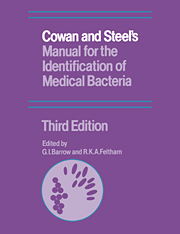Book contents
- Frontmatter
- Contents
- Foreword
- Preface to the first edition
- Postscript
- Preface to the second edition
- Preface to the third edition
- List of contributors
- Introduction
- 1 Classification and nomenclature
- 2 Culture media: constituents and sterilization
- 3 Principles of isolation
- 4 Bacterial characters and characterization
- 5 Theory and practice of bacterial identification
- 6 Characters of Gram-positive bacteria
- 7 Characters of Gram-negative bacteria
- 8 Taxonomy in theory and practice
- 9 Bacterial identification by cards
- 10 Bacterial identification by computer
- 11 Quality control in microbiology
- Appendices
- References
- Index
2 - Culture media: constituents and sterilization
Published online by Cambridge University Press: 15 December 2009
- Frontmatter
- Contents
- Foreword
- Preface to the first edition
- Postscript
- Preface to the second edition
- Preface to the third edition
- List of contributors
- Introduction
- 1 Classification and nomenclature
- 2 Culture media: constituents and sterilization
- 3 Principles of isolation
- 4 Bacterial characters and characterization
- 5 Theory and practice of bacterial identification
- 6 Characters of Gram-positive bacteria
- 7 Characters of Gram-negative bacteria
- 8 Taxonomy in theory and practice
- 9 Bacterial identification by cards
- 10 Bacterial identification by computer
- 11 Quality control in microbiology
- Appendices
- References
- Index
Summary
In the introduction to a Good Food Guide for bacteria, Miles (1965) described most culture media formulations as ‘kitchen recipes, written … by increasingly sophisticated cooks’. There are two entirely different kinds of media: those of defined composition and those of undefined composition, usually containing peptone. Defined media have disadvantages for identification because the characters of organisms grown in them may differ from those developed in undefined media (Meynell & Meynell, 1965). In general, published descriptions of bacteria refer to those characters found after growth in complex, undefined media, and because of this the results of biochemical tests do not always correspond with those obtained in defined media.
Media preparation seldom receives the attention it deserves; moreover, the media room is often overcrowded and understaffed, and the conditions in which media-makers work are often among the worst in the laboratory. Complaints about media, whether commercial or home-prepared, are still common and many laboratories have therefore set up internal quality control and assessment procedures (see Chapter 11); others have also made formal arrangements for supervision of media preparation.
In this chapter we discuss the general aspects of media making; formulae for the different media will be found in Appendix A. The majority of the commonly used culture media are now available commercially as dehydrated products, in either powder or tablet form, which are reconstituted by the addition of distilled water and then sterilized in the conventional manner. The manufacturers' directions for reconstitution should aways be followed for the best results.
- Type
- Chapter
- Information
- Publisher: Cambridge University PressPrint publication year: 1993



